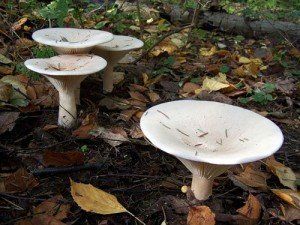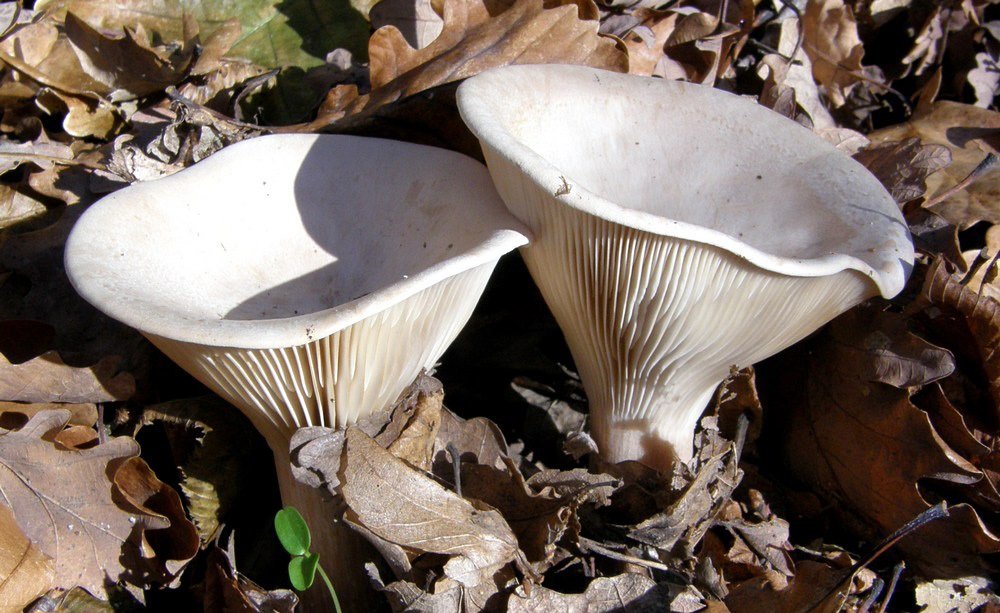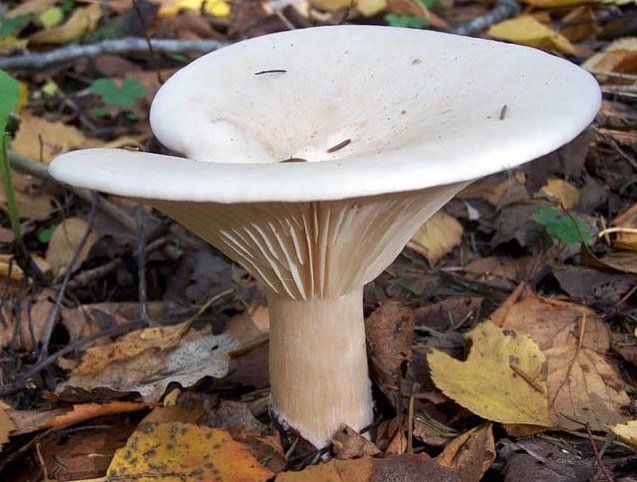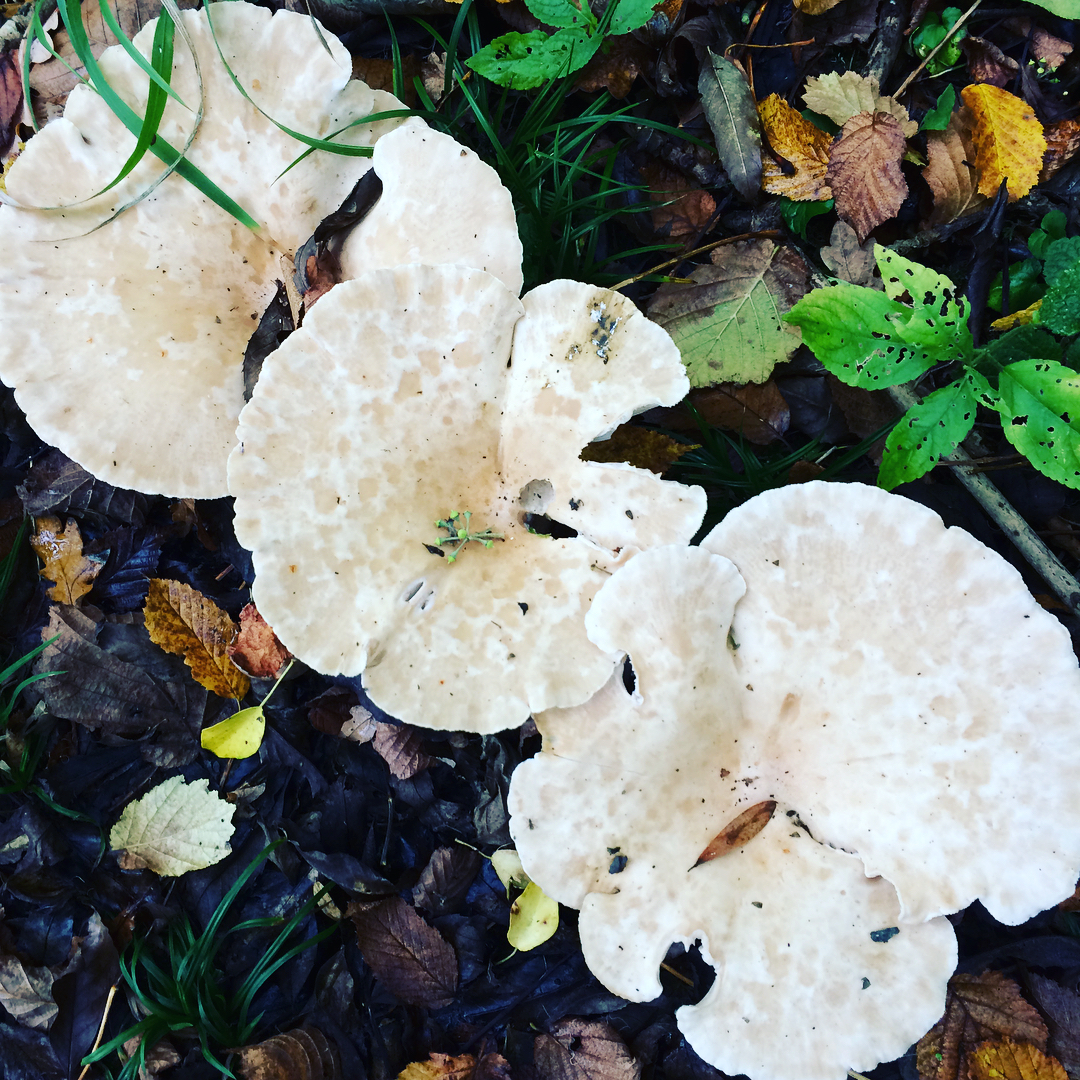Place of growth
Autumn is the time for giant pigs. Fruiting of this mushroom begins in late August and lasts until November, depending on the climate, weather and region.
He prefers this type of space and light, therefore he chooses for himself the edge of the forest, open and sunny meadows. You can see pigs both along roadsides and in park areas. They can also be found in fields and pastures.
Forest giant pigs are not particularly capricious and grow well both in deciduous and coniferous, willow mixed forests.
The giant pig is a saprotroph, that is, it grows on a litter of decayed foliage and actively participates in its decomposition and the formation of humus.
This species is very common almost throughout the northern hemisphere: Russia, the CIS countries, Europe, North America, China.
The habitat of giant talkers in our country is very large. They grow in the Caucasus, mainly in mountainous regions, and in Siberia, in the European part of the country and in the Far East.
Description of the mushroom
As the name implies, the mushroom is quite large, its cap reaches a size of 30 cm. Basically, its average size is about 20 cm. The shape is a slightly twisted funnel. The edges of the cap are wavy with lobes, and the color is white with an ash-gray tint.
The mushroom is lamellar, and the color of the plates changes from very light to cream. The plates are descending and go close to each other. The pulp is firm, white in color. The giant talker does not have a specific taste, but there is a recognizable mealy aroma. Spores are white.
The stem of the mushroom is almost 4 cm in diameter, and its length ranges from 4 to 7 cm. In relation to the cap, it is not high, but thick. In shape, it resembles a cylinder, and in color it is light, like the mushroom itself. Has no veil on itself and tapers towards the base.
It grows on the territory of Russia, mainly in its European part, and also occurs in the Caucasus. Talkers love open spaces, in particular, clearings in the forest. Interestingly, this mushroom sometimes draws peculiar circles with the location of its fruit chalk.
Clithocybe bent
The bent talker (Clitocybe geotropa), also called the red talker or bent clitocybe, grows in coniferous and deciduous forests, it can be found in forest glades and under low bushes. Most often, these mushrooms grow in groups, forming "witch circles". The fruiting period is from mid-July to the end of October.
Young clitocybe bent has an orange-brown flat cap with a tubercle in the center, gradually the shape and color of the cap changes - it becomes funnel-shaped and acquires a pale straw tint, sometimes there are orange spots on the surface. The diameter of the cap is 5-15 cm.
The plates are frequent, white or light cream in color. The stem is cylindrical, matches the color of the cap, its height is up to 20 cm, the diameter is 2-3 cm. The flesh in the cap is fleshy, in the stem it is dense, fibrous. The color of the flesh is white or "baked milk".
The mushroom is edible. The caps of young mushrooms are eaten after boiling for 20-30 minutes. Also, the bent clitocybe is suitable for workpieces - salting and pickling. The taste is pleasant, neutral.
Similar species
Giant talkers are very large mushrooms, so mature specimens are easily distinguishable from other mushrooms. But the young have similarities with many brothers and you need to learn to distinguish between them, because some of the twins are poisonous and dangerous.
- Most of all, a giant pig with a bent govorushka is similar, which is also a conditionally edible mushroom, but nevertheless, in terms of its taste characteristics, it goes far ahead of other talkers.The most important distinguishing feature between these two representatives of the mushroom kingdom is the tubercle, which forms in the center of the cap near the bent talker. In addition, this mushroom has a light ocher color, as well as a higher stem.
- Funnel talker is an edible mushroom. Although it has a funnel-shaped hat, it differs from the giant pig in the following parameters:
* A darker color (from brown to ocher);
* Sizes (the maximum diameter of the cap is 10 cm);
* Odorless (fruity aroma).
- The waxy talker (leaf-loving, grayish) is the most dangerous twin of the giant pig. This mushroom contains a high concentration of muscarine - a poison that causes intoxication and even death. The color of this mushroom is off-white with spots of ocher hue. The shape of the cap is convex at first, then the edges are turned up, but a tubercle remains in the center, and then funnel-shaped. Its surface is covered with a waxy coating, which, when cracked, can create a marble pattern. The size of the cap is 6-8 cm. The leg is thinner and longer than that of the giant talker. The shape of the leg is cylindrical, it can thicken or narrow towards the mycelium. The mushroom has a strong spicy aroma. Astringent taste. Poisoning occurs after 2 hours or more.
- Although the clubfoot talker is considered conditionally edible, it cannot be combined with alcohol. The main difference between this mushroom and the giant pig is the leg, which thickens towards the mycelium and takes the form of a mace. The color of the cap is brown from ocher to brown with a lightened stripe along the edge. The plates of this species are rare and run down the stem. The flesh is grayish in the section and has a rich mushroom aroma.
White mushroom from the Suzdal forest
Autumn is considered the most mushroom time. But you can collect them and not only in the fall. Such mushrooms as porcini, and many others, begin to appear at the beginning of June. But this is all approximate, it all depends on what the weather will be like.
The best time to go to the forest for mushrooms is 5 days after the rain. During this time, the mushroom should grow. If it is summer time and it will be very hot outside, then it is better to look for mushrooms under the trees. This is where they will hide. Porcini mushrooms love a lot of moisture. It is very difficult to find them in a drought.
A resident of Vladimir managed to find a specimen weighing 2 kg. According to the lucky owner of this miracle, the porcini mushroom was up to his knee and the diameter of the cap was about 30 cm.

But not only the porcini mushrooms love rains, but also so that the soil temperature is from 15-18 degrees. All mushrooms, as well as porcini, should be found in the forest. If you see an anthill or fern, then this is a clear sign that there are porcini mushrooms nearby. They also grow in spruce and pine forests. The largest mushrooms grow there. If you find such, then in no case pull it out. Take a knife and cut. In the future, new mushrooms will grow on the mycelium.
Places of distribution of giant talkers.
Giant pigs grow in forest glades. They can be found in the European part of Russia, as well as in the Caucasus. Sometimes giant rows form "witch circles".
Evaluation of the edibility of giant talkers.
The giant talker is edible, but it can provoke stomach upsets. This is a mushroom with mediocre taste, 4th category, conditionally edible. Giant rows can be eaten boiled or salted
It is very important to carry out the correct heat treatment of these conditionally edible mushrooms.

It is recommended to use only young talkers, as the old ones taste a little bitter. However, overripe specimens are suitable for drying.
Among the talkers, there are poisonous species, so they should be collected exclusively by experienced mushroom pickers. You should be aware that pigs are not combined with alcohol, as this can lead to serious poisoning.

The use of giant talkers for healing purposes.
The pulp of giant pigs contains antibiotics that are active against tubercle bacillus.The antibiotics are called clitocybin A and B. Giant talkers have antibacterial properties. They can be used to treat epilepsy.

After studying talkers, a large number of useful properties were revealed. They contain both animal and plant proteins, a large amount of trace elements, for example, copper, zinc, manganese, as well as vitamins B1 and 2. In addition, a variety of drugs are made from talkers: nebularin, diatretin and clitocybin.
Like other mushrooms, giant pigs are low-calorie, they can be used as a diet food. These mushrooms help to restore and cleanse the body, get rid of heavy metals, toxins and toxins.

In folk medicine, ointments and decoctions are used, which are made from talkers. They help remove stones and treat respiratory tract infections.
Related species of the giant ryadovka.
The snow talker is a conditionally edible relative of the giant talker. Her cap is convex or depressed, with thin drooping edges. The surface of the cap is smooth, gray-brown or gray-brown. The leg is dense, smooth, often curved. The pulp is odorless, with a cucumber taste, it is dense in the cap, and tough in the leg.
Snow talkers gather in May. They grow in light coniferous forests. They settle on the forest floor. Fruiting in groups. These mushrooms are rare.

A weak-smelling talker is an inedible representative of the family. In young specimens, the caps are convex, then they quickly open and become funnel-shaped. The color of the cap is brown or beige. The shape of the stem can be cylindrical or flattened; it is slightly paler in color than the cap. The pulp with a flour taste and smell, grayish color.
Low-odor talkers bear fruit in rare groups. They usually grow in mixed forests and pine forests. The growth period falls on December-January.
Giant Pig (Leucopaxillusgiganteus)
Giant pig - (lat.) Leucopaxillusgiganteus
This type of mushroom is also known under other names, which are most popular among the people:
- The row is giant;
- The white pig is gigantic;
- The talker is gigantic.
Hat
This pig is not called giant in vain, because mature specimens can reach solid sizes - up to 45 cm in diameter. This result is considered a record one. On average, giant talkers have a rather fleshy and large cap: 15-25 cm in diameter and 1.5-2 cm in thickness.
Piggy babies have neat, slightly convex or flat hats with a folded edge. But in the process of growth, the caps bend, acquiring the shape of a funnel with a depression in the center. Moreover, its edges are slightly curved or lobed and often become wavy.
The surface of the cap of young mushrooms is velvety, dry. With age, it smoothes out. The color of giant pigs in adulthood is white-fawn, ocher light specks can be observed. The color of the young is milk or cream.
The hymenophore of the giant talker is lamellar, passing to the leg. Their color does not differ from the main color of the mushroom - white, cream. The plates are dense, densely planted, unequal in length.
The flesh of these mushrooms is white and does not change color when cut. In texture, it is very dense, elastic, and uniform. The smell is neutral or slightly mealy.
Leg
The leg of giant talkers is short, no more than 6 cm. However, it is strong and rather thick - up to 5 cm in cross-sectional diameter. Usually the surface of the leg is smooth, sometimes velvety, covered with a powdery coating, the same color as the surface of the cap.
Its shape is cylindrical, the structure is one-piece. The pulp of the leg is fibrous, dry.
 Giant pig - (lat.) Leucopaxillusgiganteus
Giant pig - (lat.) Leucopaxillusgiganteus
Can it be confused with other mushrooms
Since talker mushrooms have several varieties, some of which are weakly and even highly poisonous, it is very important to learn how to distinguish them from each other so that later you do not fight the serious consequences of poisoning.Check out the list of edible and inedible talker mushrooms.
Check out the list of edible and inedible talker mushrooms.
Here are a few signs that distinguish the most common varieties:
- The clawfoot talker can be easily distinguished from other types of mushrooms - from their name you can see the characteristic structure of the leg, which cannot be confused with anything. Housewives should remember that this mushroom is more useful in nutritional quality than a giant relative, and those who are used to using mushrooms as a snack - that it is absolutely incompatible with alcohol;
- A translucent talker is considered poisonous, a hat - pink or red ocher, moreover, sticky to the touch will help to distinguish it from a giant one;
- of all representatives of this species, the bent (red) talker is recognized as the most high-quality mushroom, it differs from the giant relative not only by the red tint of the cap (which is given to it by rusty specks), but also by its lumpy surface;
- deadly waxy govorushka (it is also called grayish or leaf-shaped). Completely white, it has a convex cap with a hump-like tubercle in the center and the presence of not very noticeable concentric watery circles.
Edible and conditionally edible talker mushrooms
Edible mushrooms contain an optimal ratio of vegetable protein, vitamins, fiber and amino acids, which prevents the occurrence of various diseases. Also, these mushrooms are able to reduce plaque cholesterol in the blood.
Gray talker
Considered conditionally edible. However, some scientists categorically classify it as poisonous. The hat has a smoky appearance and reaches a diameter of up to 15 cm. The color can change depending on weather conditions and even become orange-brown. Eating can cause poisoning due to the presence of a toxin called nebularin. White dense pulp changes color when cut. The harvest occurs at the end of August and lasts until the end of December. Basically, this species grows in long rows in the territories of the northern hemisphere in forests of any type.
Giant talker
It is a conditionally edible variety of the 4th category. As a rule, this species is collected exclusively for salting. Before cooking, even before drying, be sure to boil for 30-40 minutes. This species also has the names leusopaxillus huge, giant pig, white giant snow pig. Grows in mixed, deciduous and coniferous forests. It can often be found on the edges of the Caucasus. Giant talkers grow in large groups. The crop can be harvested until October. It is possible to collect these mushrooms from August to October.
The hat has a yellowish or creamy shade, sometimes up to 30 cm in diameter. The flesh is tasteless and smells like flour. It contains an antibiotic and clitobicins, so this species is considered conditionally edible. The antibiotic is capable of destroying tuberculosis infection, and clitobicin kills germs.
These mushrooms are often used in traditional medicine to treat airway problems and lower blood cholesterol. It is also often used as an antiseptic.
Anise talker
Also known as fragrant or fragrant. This variety grows mainly in spruce and mixed forests, where the Christmas tree predominates. Harvesting can begin in July. The hat reaches up to 6 cm and has a convex shape with a wavy rim. The surface color is light green with a blue tint. Another feature of the species is the length (up to 4 cm) and width (up to 1 cm) of the leg. To the base, the leg expands slightly and acquires a brownish tint. The flesh of the mushroom is distinguished by its strong aniseed odor and has a slightly greenish color. The conceived aroma can be easily felt even without bending over to the ground.
The gift of the forest is eaten only after boiling. After that, you can fry it, add it to pies or salt it. It is better to choose young mushrooms with fleshy pulp.
This type of talker can be distinguished due to its specific smell and color.Field champignon has a very similar smell, but its color is very difficult to confuse.
Reproduction and nutrition
The offspring will go through several stages:
- egg;
- larva;
- chrysalis.
Further, the transformation into an adult insect takes place. The wasp will provide food for its own offspring. To this end, she looks for small pests in the form of larvae:
- rhinoceros beetle;
- bronze;
- May beetles.
The wasp's task will be to immobilize its victim. Taking into account the fact that her young animals act mainly in the role of parasites, it is necessary to deliver the prey in a live form. The wasp uses a sting to neutralize the nervous system of its prey.

The next stage is the laying of eggs in the victim's body. If the larva forms, it will begin to feed, destroying the least important organs first. In the end, the circulatory system and the central nervous system will remain. The duration of this process is 12 days. Growth is associated with molting (observed 3 times). After finishing feeding, the larva will cook a cocoon inside the dead insect. This will take approximately 24 hours. The cocoon resembles an ellipse. The length will vary: 1.8-2.5 cm. The protective membrane is formed with the help of salivary glands producing a silk thread. The next stage is the formation of a pupa. This condition lasts approximately 4 weeks. In April, an adult wasp emerges from the cocoon. Its tasks are:
- continuation of reproduction;
- food extraction (flower nectar);
- burrow creation.

It should be noted that there is no definite structure in the wasp burrow. The insect moves chaotically, choosing different places to enter the soil. Laz will be destroyed if the giant wasp leaves its own home.
Basically, the burrow of a giant scolia is located near a potential victim.
Wasps hunt for prey, in which the nerve nodes are close together. Having found it, the female goes on the attack - it bites directly into the abdominal nerve that controls coordination. Thanks to this, the wasp does not kill the victim, but immobilizes it. This allows food to remain fresh for a long period of time.
Eating also has characteristic features - the secondary organs are initially eaten, and then the main ones. When such a sequence is violated, then after an extremely short period of time, the production will begin to decompose. However, in nature, these errors are impossible. Scolia hunts underground, so the actions are not visible to observers.

Characteristics and description of the inedible mushroom
The orange talker, or false chanterelle (Higrophoropsis aurantiaca), is a mushroom of the Higrophoropsidaceae family.
Scientific classification: department - Basidiomycetes, class - Agaricomycetes, order - Boletiaceae, family - Gigroforopsis, genus - Gigroforopsis, species - Gigroforopsis orange.
International scientific name: Hygrophoropsis aurantiaca (Wulfen) Maire, 1921.
Other names: false chanterelle, bent talker, orange Gigroforopsis, kokoshka.
Latin names: Hygrophoropsis aurantiaca, Agaricus aurantiacus, Merulius aurantiacus, Cantharellus aurantiacus, Clitocybe aurantiaca, Agaricus alectorolophoides, Agaricus subcantharellus, Cantharellus brachypodus.
Hat
It is small, with a diameter of 2 to 5 cm. In only sprouted mushrooms, it is first convex, with a curved edge, then flat-spread, with a depression in the center, in the form of a funnel with a curved and straight thin edge. The color of the cap is orange- or yellow-ocher, fading to pale yellowish with a bright lemon center and a whitish edge during the growing season. It is smooth and pleasant to the touch.
Hymenophore
This is the lower part of the cap containing a thin spore-bearing layer. The surface of the hymenophore is highly developed, which allows it to produce a large number of spores. The type of this part of the fruiting body is important both in determining the families of fungi and in identifying species of the same genus.
The plates of the hymenophore of the orange talker are folded, often arranged, thick, descending (descending from the cap to the leg). Bright yellow-orange color, turn brown when pressed with fingers.When the fruiting body is fully ripe, a white spore powder is formed in the hymeniums of the fungus.
Cut pulp
In the center of the cap it is thick, closer to the edges it is thin, rather dense, with age it acquires a cotton-like structure of yellow color. In the leg it is always tight, hard, reddish.
Leg
Thin, 3 to 6 centimeters long. In diameter - up to 1 cm, cylindrical, tapering towards the base. Bright yellow-orange color, like the records. The bottom of the leg is always darker. Depending on the type of soil (if it is dense), it can bend at the base. In young mushrooms, the inner part of the stem is solid, becoming hollow with age.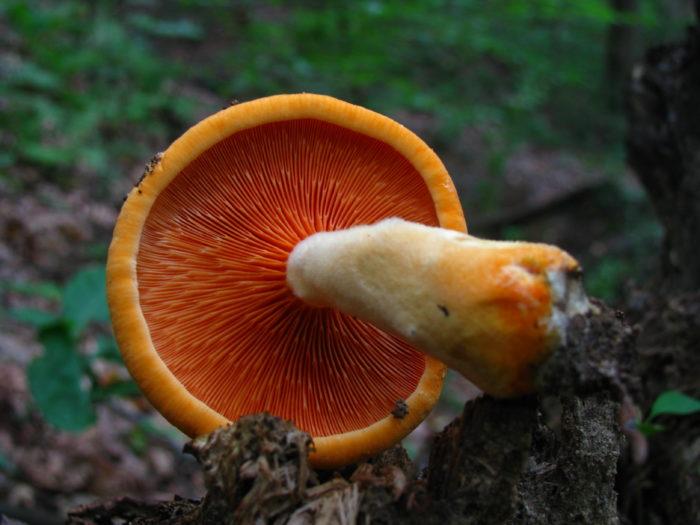
A bit of history
The false chanterelle was first described by the Austrian naturalist Franz Xaver von Wolfen in 1781. He noted its similarity to the real one and the fact that mushroom pickers often confuse these two species. Later, in 1900, the French botanist and mycologist Rene Charles Joseph Maire identified the false chanterelle as a talker (Clitocybe). Together with the adjective "orange", this became its second name.
Giant Talker
Giant is usually larger and does not have a tubercle in the center of the cap. And on the cap of a very poisonous whitish talker there is a characteristic mealy bloom.
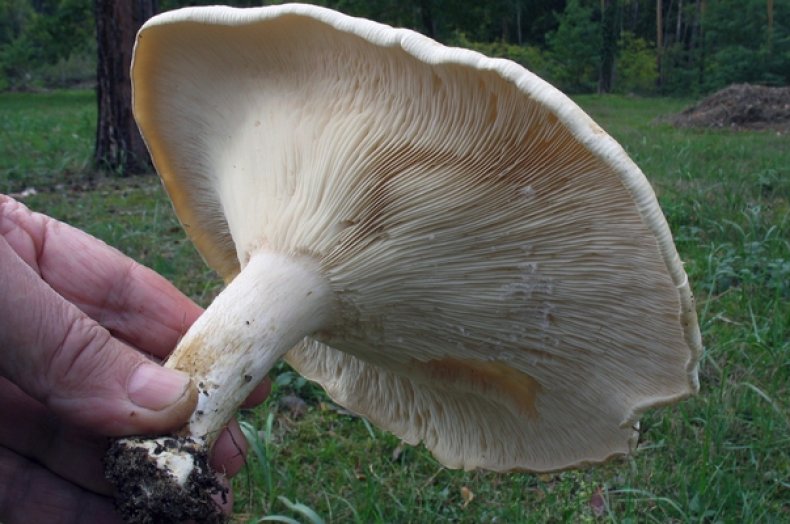
When it grows: from early July to mid-October in temperate countries of the Eurasian continent. Eating: in any form.

This is a delicious mushroom, but experienced mushroom pickers advise using only young talker hats for culinary purposes, since the old ones can be tough. Smoky talker hat Clitocybe nebularis diameter cm: glossy, usually ashy, dirty yellow or light brown, strongly fades in the sun and can become almost white or light gray.
It has the shape of a hemisphere, with a slight bulge in the center, over time it becomes almost prostrate. The edges are usually wavy and uneven.
Smooth to the touch.
Along with the poisonous ones, there are a number of edible talker mushrooms that are eaten after preliminary boiling. They differ from inedibles by their brighter color and less tart aroma. Most often, chopped talker mushrooms are used as a filling for pies, since they are harsh when boiled or fried. Below you can find photos and descriptions of talker mushrooms, find out about the places and season of their distribution, their use in cooking and doubles. Category: edible.
Leg height cm: smooth or with a slight white bloom, slightly lighter in color than the cap. As you can see in the photo of the smoky govorushka, the stem of the mushroom is very dense, usually has a strong thickening almost at the very base.
Giant talker (Leucopaxillus giganteus)
Blades: Usually dirty or light yellow, thin and frequent. They do not adhere to the stem and are easily separated from the cap.
Giant talker Leucopaxillus giganteus - this mushroom is considered conditionally edible in the 4th category. Salting of these mushrooms is popular.
Flesh: firm, white in color, which does not change when cut and when interacting with air. The taste can be sour, very sweet or spicy.
And the smell can resemble the acrid smell of rot, or the scent of flowers or fruits. Doubles: pewter entoloma Entoloma sinuatum, but it has an ocher-colored cap and light pink plates.
When it grows: from early August to mid-November in temperate northern hemisphere countries. This mushroom is also called the giant pig and the giant ryadovka. This is a conditionally edible mushroom. As the name implies, this is a large mushroom - the head of a giant talker is centimeters in girth.

The shape of the cap is weakly funnel-shaped. The edges of the cap are lobed-wavy. The color of the cap is white-ash. A giant pig is a lamellar mushroom, under its head there are plates.
Their color is white, later cream.
Features of growing cephalaria
When planting cefalaria, it should be borne in mind that this plant is constantly growing and gaining power, it becomes more beautiful and larger. Cephalaria are pleasantly surprised by the fact that they attract not only all possible honey-bearing insects and typical pollinators, but also different types of butterflies. Therefore, you need to choose a place for a plant where it can grow freely for decades and where there is no active movement that can scare away insects.
 Cefalaria is a magnet for butterflies. matilde.l
Cefalaria is a magnet for butterflies. matilde.l
Cephalaria are light-loving plants that prefer to grow in sunny areas, but they tolerate a little shade very well. The plant is absolutely undemanding to soils, it can develop and bloom both on poor and on fertile soil, with almost any reaction and composition of the soil.
When choosing a place for cephalaria, it is worth remembering that on moist soils or with regular watering, the plant grows at a gigantic pace and reaches enormous sizes. Therefore, when introduced into complex compositions, cephalaria, flower beds and mixborders are planted in combination with drought-resistant crops.
How to distinguish false talkers from true ones
In the variety of types of talkers, it is very difficult to choose edible ones. However, a universal rule of difference has not yet been invented. The main rule is excellent knowledge of the characteristics and differences between the types of talkers. It is known that among the mushrooms in the wild, poisonous mushrooms are often found, visually practically indistinguishable from those suitable for human consumption. The main factors are smell and color. A mealy and pleasant smell is often attributed to poisonous mushrooms.
Some types of talkers are distinguished by pink plates and spores, as well as the absence of circles on the cap, like in edible mushrooms. Only experienced mushroom pickers can distinguish edible, conditionally edible from poisonous and inedible
Methods for making talkers
In cooking, only hats are used, the legs have no taste. Young mushrooms have a delicate fruity aroma that is lost with age. Talkers can be added to all traditional dishes boiled, fried, pickled and dried. The aroma is perfectly revealed in the first courses and sauces. The specific enzyme of mushrooms in its raw form gives the dishes a not very pleasant bitter taste.
It is not recommended to use talkers with alcohol. The wide area of growth of govorushki favors their presence in various dishes of different nations.
Talker Salad
Dice boiled potatoes, beets, and carrots. Cut fresh onions into half rings and add to vegetables. Then mix all the products with pickled mushrooms and canned peas. Salt to taste, add a couple of drops of lemon juice or unrefined sunflower oil.
Pickled salad
Mix crispy pickled cucumbers with coarsely chopped pickled talkers. Cool boiled potatoes and cut into cubes and add to the rest of the ingredients.
Despite the variety of types of talker, this mushroom has taken its rightful place at Russian feasts. The mushroom requires careful handling and heat treatment before eating.


